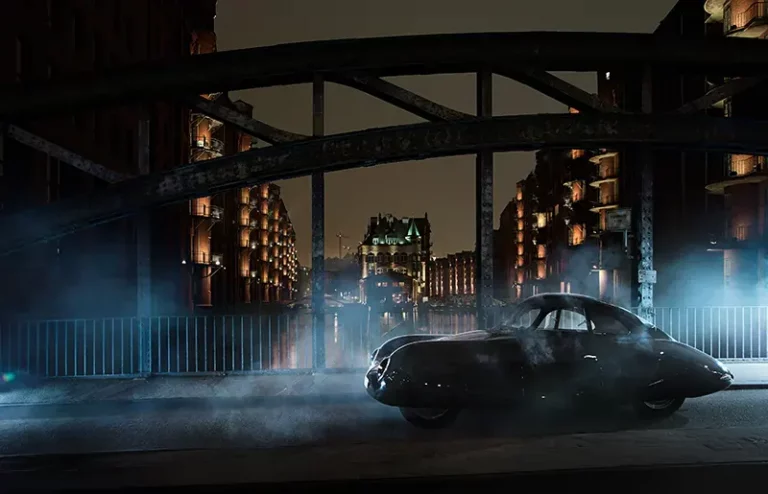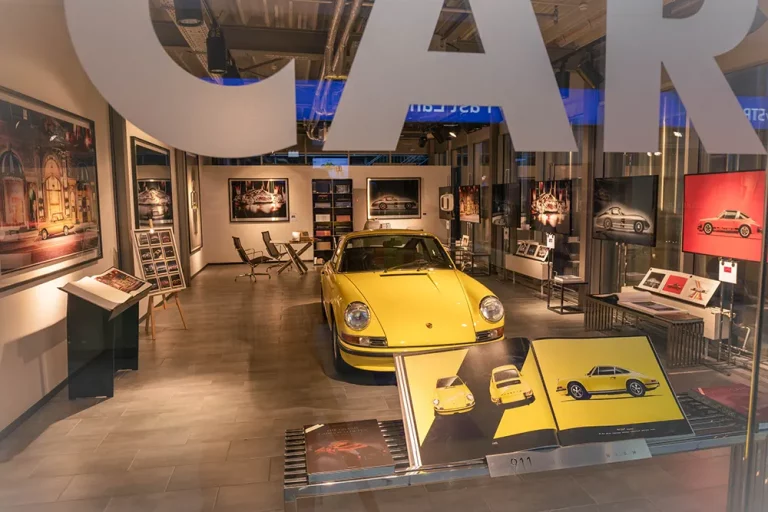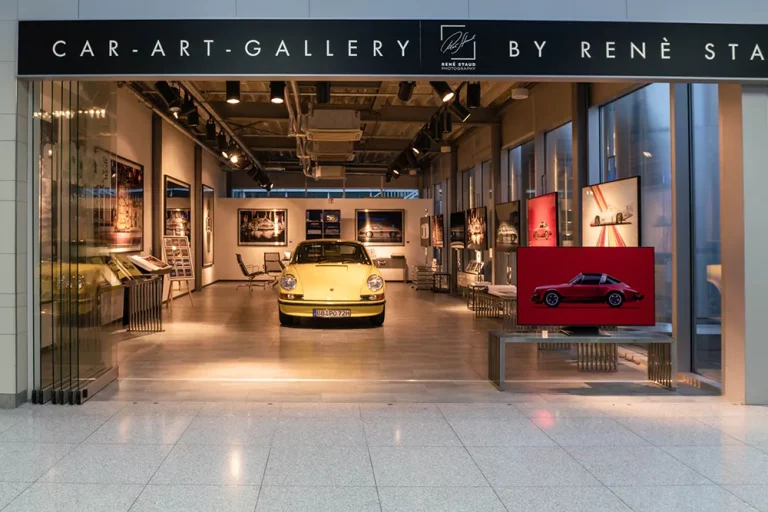
Greetings from Dubai
It is probably the most exclusive Porsche meeting in the world, definitely the largest automobile festival in the Middle East – the Icons of Porsche

Five decades of car photography: from the first car in the studio to the MagicFlash and today – an overview
I started taking pictures when I was twelve years old, when I was still at school.
My father was a wood sculptor, and money was tight at home – who had a need for carved lamps and figures in the post-war years?
However, I had noticed something that was a hindrance on top of that:
My father never had anything to show when he was negotiating a job.
After all, once he delivered a figure, it was gone – after he had worked on it for weeks.
So I took his expensive camera out of the closet and started taking pictures of his work, photographing him at work.
I tried out how to literally put cabinets, chairs and sculptures in better light – and began to stage them.

In fact, pretty soon my pictures helped the father more than recommendations and word-of-mouth.
And I had learned my lesson: a picture is worth a thousand words.
At the Stuttgart Youth Center, you could take courses; I learned pottery, weaving, batik – and how to take better photographs.
At 14, I set up my first black-and-white lab at home, and at 15, I expanded my business: On Saturday afternoons, there was always a tea dance in our neighborhood, and I went there and photographed the couples. The next week I sold them the pictures.
I won my first competitions, expanded my laboratory, was able to afford a moped at 16, and understood that good work brings something in return – in the form of money, for example.

Everything that has two or more wheels and goes fast has fascinated me since I was a little boy: There’s a picture of me at the age of two climbing onto my father’s motorcycle, a Horex with sidecar – our family vehicle.
When I was four, I took part in soapbox races, and when I was eight, I stopped in awe for the first time in front of a Porsche parked in our neighborhood (a model 356 coupe).
When I was 25, I got my racing license.
>> The shoot that started it all: How we “discovered” Fuerteventura and made it a vacation island
At the time, I had completed my photography apprenticeship and was already self-employed as a photographer.
I had my own small Stillife studio in Stuttgart, with a lab and a first employee.
Two years later, at 27, I took over a 350-square-foot studio and built my first studio team.
I mainly photographed furniture, set up showrooms and staged beds and wall units (or, as here, tiled stoves) in them – while my passion was clearly for fast cars.
Couldn’t cars also be staged in this way…?

Until the late 1970s, cars were photographed outside. The Porsche on the curved track, with the diesel into the green forest…
More and more often I thought that the design of the vehicles should be made much clearer.
Why didn’t anyone do that?
No one did it because a car in the studio could not be photographed with the normal flash.
Yes, well – then we’ll just build the lightning we need ourselves.
I started with experiments in a shoe box. The result is the Magicflash – my patented flash system. I would say the revolution of car photography.

The Magicflash is a light tray with many small flash rods that create a kind of light carpet – since then, the design of car models can be brought out quite strikingly.
>> Magicflash – that’s why the carmakers were now lining up for me
The Magicflash gave me my breakthrough: from one day to the next, my studio was fully booked, all the carmakers in the world brought their vehicles to my studio.

The emergence of sports car culture in Germany is unthinkable without the Porsche 365.
At the same time, it has the heritage of the Porsche 911.
For one of my illustrated books, I took several dozen Porsche 365s from museums and private collections and photographed them in my studio.
>> The Porsche 356 – seven selected beauties






“My Porsche Book”
is a revue of the best, most beautiful, most extraordinary variations of the classic car from the 1950s – my car photography really comes to life through the texts by automotive journalist Jan van Rossem.
I also had the most expensive car in the world in my studio.
Mercedes Benz’s famous “Uhlenhaut Coupé” – named after the carmaker’s chief developer at the time – was auctioned off in 2022 for a staggering 135 million euros.
A private collector secured the precious piece.
We photographed the 300 SLR in the 80s, even then it was incredibly valuable, and therefore incredibly costly to get into the studio. The insurance for that one week alone cost me 11,000 D-marks.
But it was already clear to me at the time that it would be a good investment: only two of the model were built, and no one has staged this car like I have – there aren’t many pictures of the legendary coupe.
One of the two (the one with the blue interior) was driven by Rudolf Uhlenhaut himself, as a company car. It is now in the Mercedes Museum. The other, with red interior, is what was auctioned. (“Auction proceeds are seed money in transition,” reads the corporate website of Mercedes Benz.)



Uhlenhaut was known for taking the coupe for a full ride. At that time, the car was capable of 300 km/h – and the engineer was able to achieve this speed, unthinkable today, on a normal highway.
His record: from the office in Stuttgart to a meeting in downtown Munich, on a weekday around noon, took Uhlenhaut just under an hour and a half.
>> The 300 SLR Uhlenhaut Coupé – my photo of the month
Of course, the 300 SLR also has a very special meaning for me in car photography: When I made the first calendar with models of the Mercedes 300 SL Type 129 in 1989, it was important to me that the Uhlenhaut coupe was included as an “ancestor”.






As someone who has traveled the world extensively for decades, I’ve always wondered why airports have so little connection to their respective cities. There are very few airports in the world that can be located: If you woke up in the morning at an airport, you wouldn’t be able to tell if you were in the U.S. or Asia.
In Stuttgart, I always thought to myself: In the city where the automobile was invented, you have to be aware of the car!
That’s why I asked the airport boss if we would do an exhibition.
Since the beginning of the year, you’ll find a slice of five decades of car photography at Stuttgart Airport, on the departures level, right at the entrance to Fast Lane.
For the exhibition I have added to my collection of wall paintings, you will also find smaller prints in 30×40 centimeters in my pop-up gallery, as well as books, calendars and postcards with my 125 most important motifs, all on the finest Hahnemühle paper.
In other words, the “best of” my car photography in every format imaginable, so you can wallow in images for hours before you take off.
It’s great for me that I now have another showroom in addition to the studios in Leonberg: In the studios we have secret and confidential cars there for more than half of the year, so I’m restricted and can only show visitors around to a limited extent, unfortunately.

It is probably the most exclusive Porsche meeting in the world, definitely the largest automobile festival in the Middle East – the Icons of Porsche

Car brands with G are often searched on Google for the crossword puzzle. But did you know that the brands often have a super interesting story? I have compiled five carmakers with a G and the most important information about them here for you.

More of the same? Then get my mails
Now that I’m out of the operational business of Staud Studios, I finally have time for all my projects – books, exhibitions, lectures… Sign up with me, and I’ll keep you updated once or twice a month.